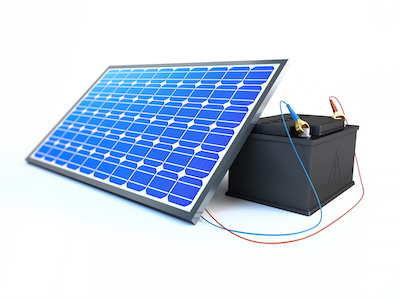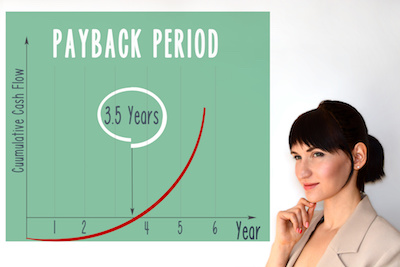Installing solar panels on rooftops is an increasingly popular trend all across the country.

The idea of generating your own electricity as opposed to buying it from the local utility has been enough to convince some to make the switch. Others are left asking are solar panels worth it? While utility or commercial solar panels cost less than those used for residential solar systems, home solar systems can still be very cost competitive. The electrical cost per square foot of many homes are so high that solar can help them drastically reduce these costs.
Below are some questions that will be answered throughout this article to help you better estimate the average cost of a solar system and determine, are solar panels worth it:
-
What Are The Components Necessary To Build A Solar System?
-
Why Is A Per Watt Price The Best Way To Figure Out The Cost Of Solar?
-
How Can You Calculate Your Return On Investment?
-
What Are Some Financial Incentives That Can Drive Down Your Payback Period?
What Are The Components Necessary To Build A Solar System?
While solar panels themselves usually get all the glory, it is important to realize that they are not the only cost that goes into building a solar system. The cost to add onto house solar depends on a variety of factors. First, homeowners must also pay for the racking unit that the panels must lock into on your roof or on an adjacent piece of property. The price of a racking unit will depend on the electrical cost per square foot because a larger system will require more racking.

Another cost to consider is the cost of an inverter. An inverter is the piece of electrical equipment which converts direct current (DC) electricity, which is the type that a solar panel produces, into alternating current (AC), which is the type that you would receive from a normal outlet in your home. Also, a homeowner must pay for all of the wiring that carries this electricity from the panels to your home. Additionally, the cost to replace electric panel or electric panel upgrades should be taken into account if your current one cannot accommodate a solar system. Other costs include paying the construction team to install your system using a solar panel installation guide and perhaps even solar financing costs if you are unable to outright pay for the system in cash.
Why Is A Per Watt Price The Best Way To Figure Out The Cost Of Solar?
Because of how rapidly solar technology has improved, it is sometimes difficult to discern two panels that may have a very different wattage from one another. To illustrate this, let’s think of two solar systems each consisting of 10 panels. The first system utilizes old 210 watt polychrystalline panels while the much newer system uses more modern 400 watt monochrystalline panels. The first system would be rated at 2.1 kilowatts while the second is rated at 4 kilowatts. From the outside, the two systems are exactly the same size and have no discernible differences.

In reality, these two systems have a very different level of power output and have very different costs. Polychrystalline panels tend to be much cheaper but produce less power. Monochrystalline panels produce much more power per square foot but have a higher cost. To best figure out your solar panel ROI, it is imperative to normalize the cost of your system. The best way to do this is by taking the total cost of the solar system and dividing it by the total wattage of all the panels. This will give you a cost in dollars per watt. That way, you’ll be able to compare a variety of quotes on a level playing field to figure out who is offering you the best deal for your money. A great rule of thumb is that solar typically costs around three dollars per watt. Commercial solar panels cost less because they are bigger systems and typically cost closer to two dollars per watt. Large utility scale projects typically cost around one dollar per watt. So, if a homeowner wanted to implement a three kilowatt or 3,000 watt system, they could expect to pay around $9,000 before utilizing any incentives.
How Can You Calculate Your Return On Investment?
Solar panel ROI can vary depending on where your solar system is located, what type of incentives you are able to take advantage of and how good your credit is to take advantage of better solar financing rates. One of the most accurate ways to figure out your detailed return on investment is by using a wattage cost calculator or an electrical installation cost calculator. If you don’t have a wattage cost calculator or an electrical installation cost calculator, there are a few rules of thumb that can be utilized to figure out your power home solar and roofing return on investment.

First, you must get a quote for the solar cost to add onto house systems and any other additional fees such as the cost to replace electric panel in your home. Then, you can use a solar panel installation guide to estimate the number of kilowatt hours that your system will generate in a year. Next, you should look at one of your electric bills to see the cost of the electricity you are currently buying from your utility. Next, multiply your cost of electricity by the total number of kilowatt hours it will generate in a year. This will represent your annual savings. Finally, divide your total quoted price plus the cost of any upgrades by your estimated annual savings. This number will represent the number of years it will take for the solar system to pay for itself. Any power generated after this point can be viewed as “free” to the homeowner. Installing solar panels on rooftops is a great way to provide clean and reliable power generation for upwards of three decades for homeowners.
What Are Some Financial Incentives That Can Drive Down Your Payback Period?
Perhaps the most common financial incentive for homeowners who install a power home solar and roofing solution is the Federal Investment Tax Credit (ITC). The Federal ITC is a 30% tax credit that homeowners can file on the following year’s tax bill. So, for example, if your solar system ends up costing $9,000, you will be able to get a tax credit the following year equal to $2,700. This means your total out of pocket cost is only $6,300 thus greatly driving down your payback period. Additionally, some states implement Renewable Portfolio Standards which give homeowners the ability to sell Solar Renewable Energy Credits (SREC’s). An SREC is generated for every Megawatt-hour that your home solar system generates. These SREC’s can then be sold to either a utility or a business who needs to meet sustainability goals which gets you even more payment from your solar system.

Some states even offer incentives for solar watts per square foot. This most commonly applies to new construction buildings that are going to incorporate solar. By cashing in on a solar watts per square foot incentive, home builders can lower the total cost of construction and raise their total profits. Regardless of whether you can only take advantage of the Federal ITC or have additional incentives from your state or local utility, any additional incentives lower the time for you to see a return on your investment and help to make solar an easier choice for consumers.
By understanding that the average solar system costs roughly three dollars per watt and then subtracting out any available solar financial incentives, homeowners can make a much more informed decision about whether or not a home solar system is right for you.
